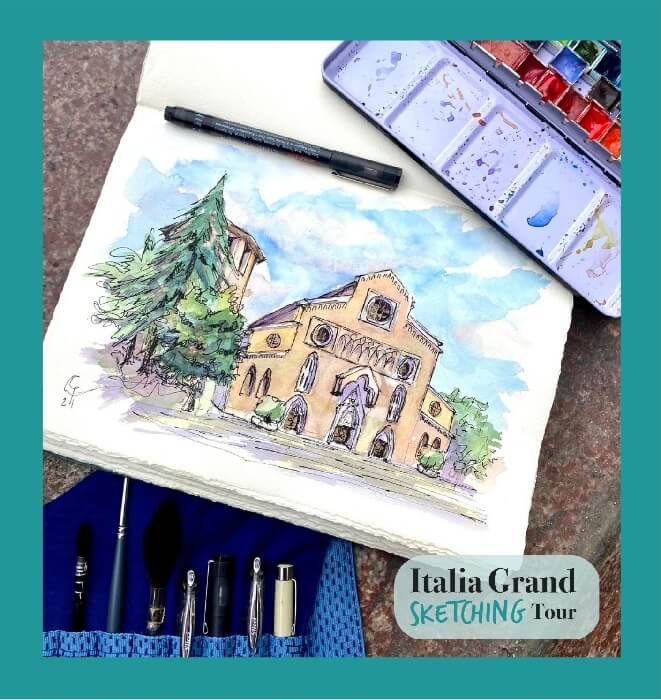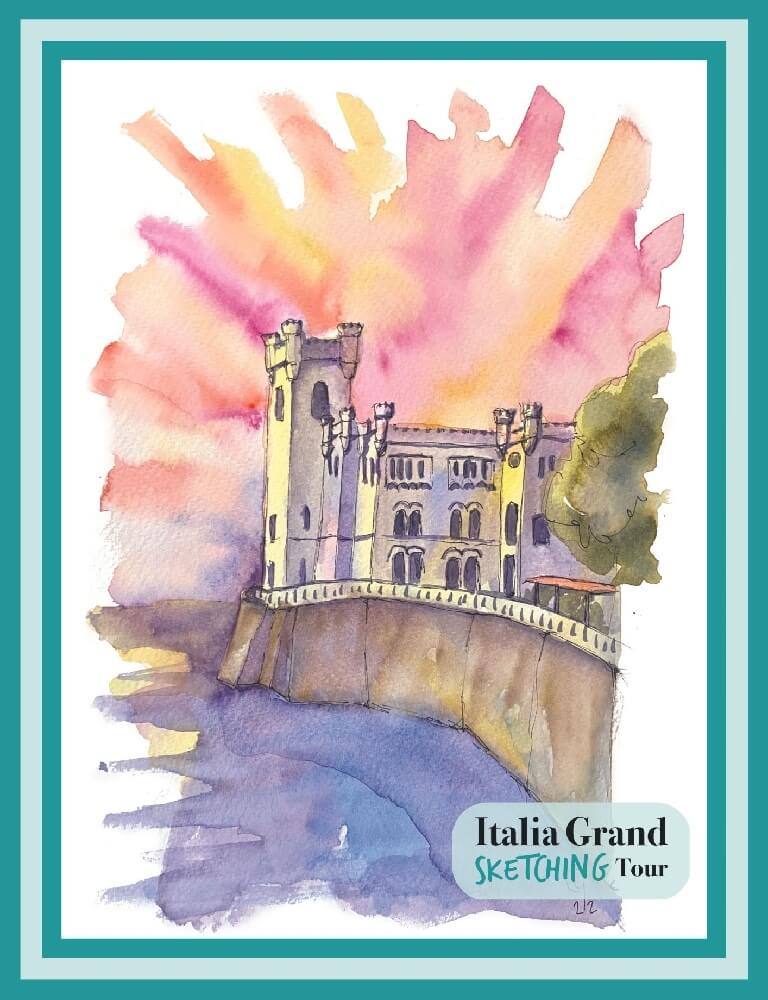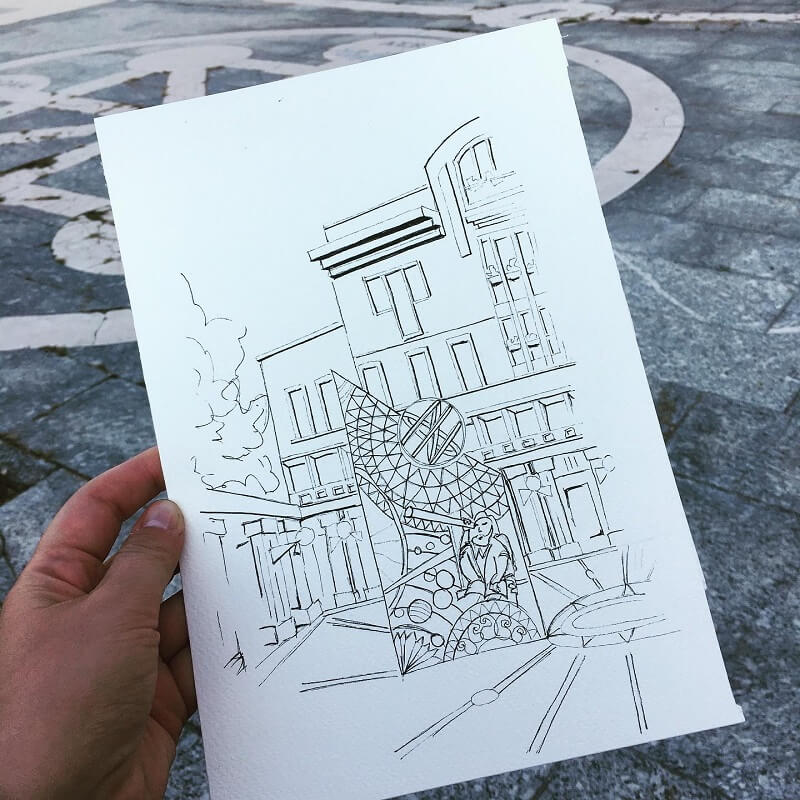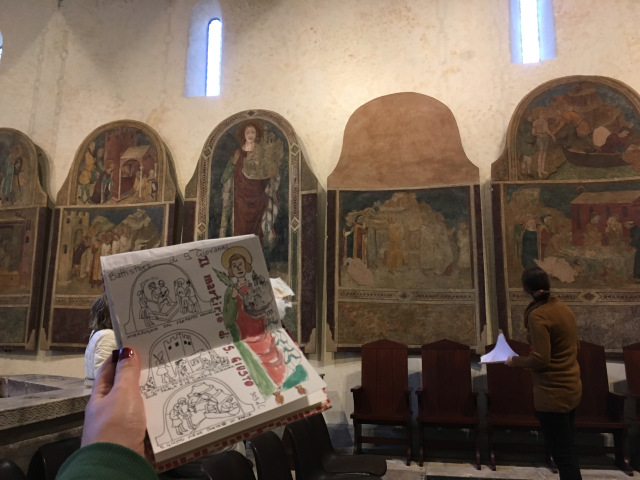The places you can’t miss in a tour of Udine narrated in watercolor
Udine is a city that I only got to visit a few years ago and it immediately struck me for its refined and almost delicate atmosphere. One of the features that you notice more are the many waterways that cross its center and remind you of a small Venice on the mainland. In the historic center it is possible to stroll discovering wonderful palaces and unique decorations, as if you belonged to another era.
Udine is at the center of Friuli and with Trieste they are the most important cities of the region. They are two very different cities and yet they are both very fascinating precisely because of the uniqueness of their style. In Udine, in every corner I stop there is a glimpse that I would want to capture with my watercolors to narrate the beauty that this city communicates to me.
Today I will tell you 9 places in Udine you cannot miss during a visit. Some fascinated me during the Italia Grand Sketching Tour and others I discovered in my subsequent visits.
Let’s go!
1. The Cathedral of Udine dedicated to Santa Maria Annunziata
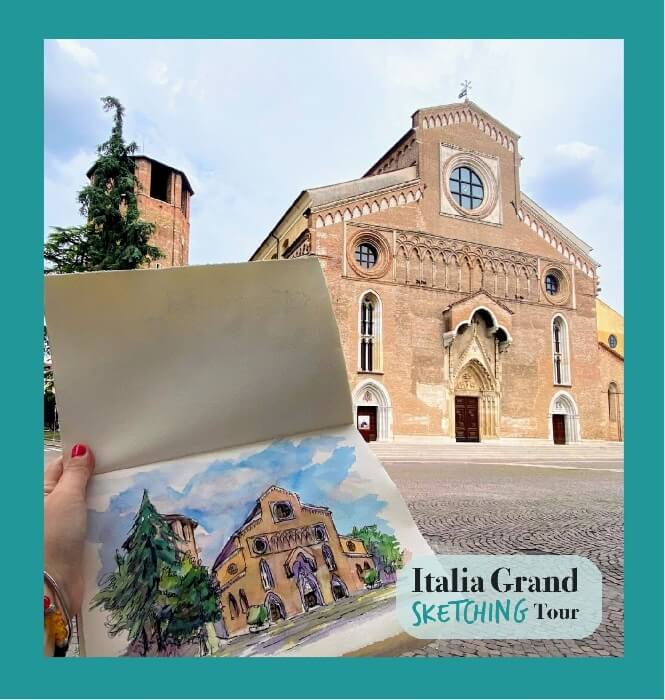
Udine Cathedral has a troubled history. It was built in 1236 according to Franciscan designs and it was then consecrated to Santa Maria Maggiore. Later in 1335 it was damaged by the earthquake of 1348.
In the 18th C. it was transformed and reconsecrated with the name of Santa Maria Annunziata. Again in 1900 the church was restored and brought back to the original fourteenth-century façade in Romanesque-Gothic style.
The bell tower is perhaps what most caught my attention for its octagonal shape. The reson behind it is that it was built above the baptistery in 1442.
Painting this church sitting in the sun made me discover a lot of details that I hadn’t noticed in my previous visits.
2. Visit Udine through the historic gates
To enter Udine you have to go through one of its gates. Originally there were 13 and they were distributed along five walls built concentrically starting from the Middle Ages until around the 16th century.
The gateway to the castle dominated by the lion was located on the first circle. Porta Manin belonged to the third circle. It was built in 1200 and was then modified over the centuries. Today it is the access to the historic center from the eastern part of the city.
Moving on to the fourth circle, remains standing the Torriani gate or tower of Santa Maria. It was built in 1295 and is now atthe entrance of the street with the same name. Porta Aquileia remains from the fifth round of walls. It opened onto the road leading to the Patriarchate and was completed around 1440. However, numerous remains and indications of the gates remain throughout the city which can become an entertaining way to visit Udine.
3. The Rogge of Udine
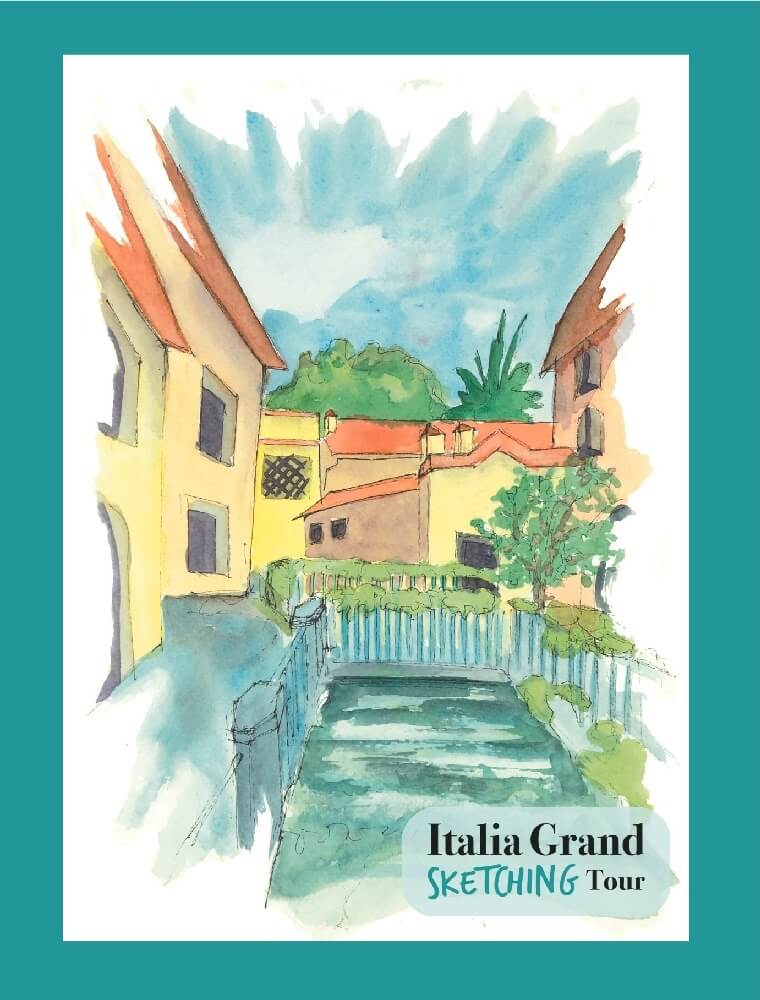
This is the specific name of the waterways that cross the city center. Having drawn this fascinating glimpse into Vicolo della Banca, I then searched more information about it.
Udine was founded when it was possible to tame the waters of the Torre river to bring them to this area.Before the water was dispersed among the gravel of the plain. Later the river was channeled into two irrigation courses called the Cividina canal and the Udine canal.
In the 19th Century, the Ledra canal was also added. It runs in the middle between the two. It was this canal that allowed Udine to expand to its current size.
4. La Ghiacciaia
This is the ancient ice palace in the historic center of Udine. The city was very famous for ice a hundred years ago. It supported the local economy by increasing the commercial possibilities of the area.
Now La Ghiacciaia is a restaurant, after becoming a tavern in the early twentieth century. I’ve never been able to eat here but the atmosphere of this place is very suggestive. Especially in spring when the wisteria is in full bloom on the terrace.
5. The Old Dormisch Brewery
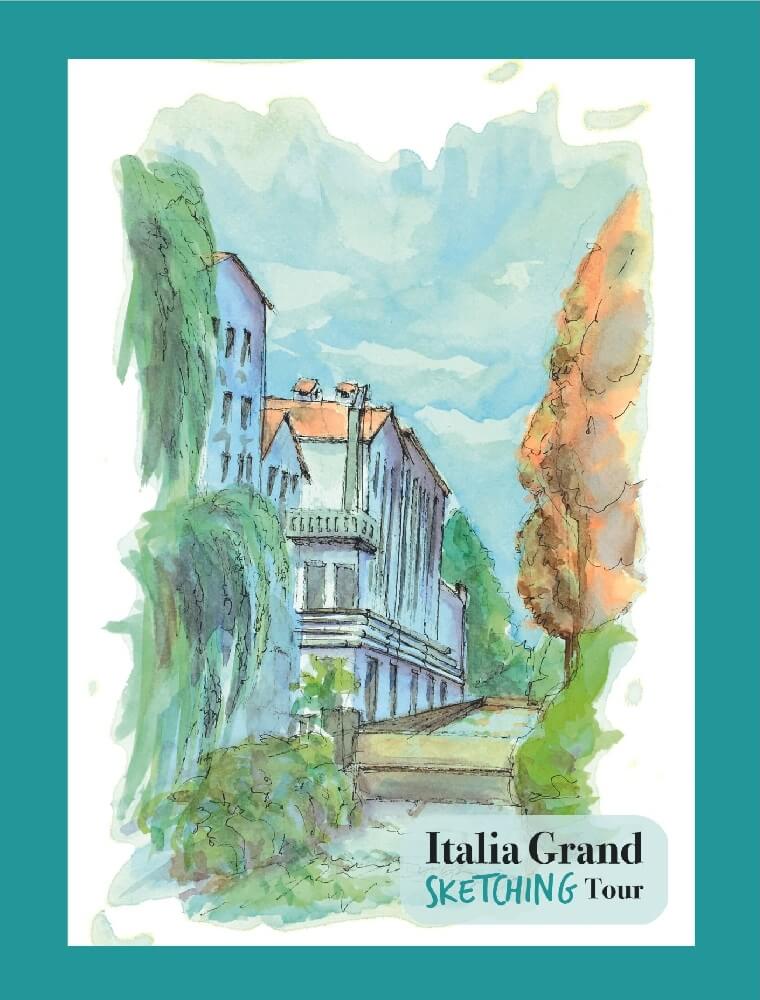
This is a painting I am particularly fond of because its subject no longer exists. It was demolished in the summer of 2022 because it was no longer usable due to a fire that occurred in 1999.
The Dormisch brewery was founded in 1881, at the same time as the Moretti brewery. The brewery worked thanks to the water carried by the Rogge that flanked the building as seen in my watercolor.
Beer production enriched Udine’s economy throughout the 1900s and the last Dormisch beer was produced in 1988.
6. Piazza XXVI Luglio and the war memorials
Out of the conventional tours of Udine, this square hosts a majestic 1925 ossuary temple in honor of the fallen of the First World War.
In the square in front, a modern monument was built after Udine received the Gold Medal for Military Valor in the war of liberation against fascism. The two monuments are by the architects Valle, father and son, who managed to create a bridge between two completely different styles.
7. Former fish market
One of the things that remains for me to see in Udine is the photographic gallery dedicated to Tina Modotti, the famous photographer born in Udine on 17 August 1896.
The palace is an admirable example of an Art Nouveau building dating back to the end of the 1600s. When it was enlarged in 1900 thanks to the demolition of some neighboring houses, the building was modified as it is seen today. The ground floor was used as a fish market, according to the style of the Tuscan Renaissance, and remained destined for this until the 1990s.
8. Piazza Matteotti: Udine’s fancy square
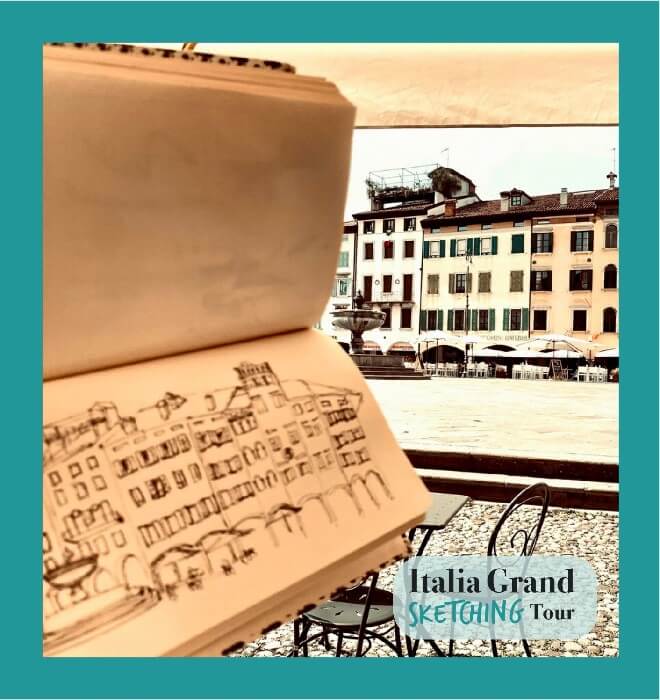
This square is perhaps the most suggestive thanks to the raised parterre. In the middle are the 16th Century fountain and the column with the Madonna. All around, on three sides, you can admire the historic arcaded houses. In some cases they still show ancient frescoes on the facades and conceal precious carved wooden ceilings inside.
The fourth side of Piazza Matteotti is dominated by the Church of San Giacomo which is sometimes used to name the square. Another name given to it is Piazza delle Erbe because of the itinerant market that used to take place here in the past.
A break for lunch or an aperitif cannot be missed given the vast number of places with outdoor tables that make this space even more unique and enjoyable.
9. Piazza della Libertà
We conclude the visit of Udine in Piazza della Libertà, Freedom Square. This is the place that, in my opinion, most resembles Venice. The Loggia del Lionello occupies the lower part of the square. Over the centuries, the Venetian Gothic-style loggia has become a single corpus with the Palazzo degli Uffici Municipali.
On the other side of the square are the entrance to the Castle of Udine, the Loggia di San Giovanni and the Clock Tower. I enclosed this complex in an unfinished drawing (but it’s on the to-do list). You can see it being created in this short video that I shot when I was in Udine.
The video tells you about the city through the eyes of the artist:
Do you want to continue the Tour with me?
This short visit to Udine ends here. There would be so many things to see. Don’t hesitate to plan a trip to this area that will surprise you.
If you want to continue exploring northern Italy thanks to my drawings and stories, you can order your copy of the Italia Grand Sketching Tour – Volume 1. My book will take you to the discovery of Veneto, Friuli, Lombardia and Trentino.
You can order it in Italian or English in all Italian bookstores or online on the Amazon shop for your country.
